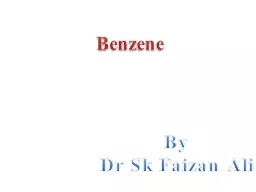

AROMATIC HYDROCARBONS Benzene Synonyms Benzol Benzole Benzolene Coal naphtha Phenyl hydride Annulene Carbon oil Cyclohexatriene Mineral naphtha Motor benzol Phene Pyrobenzol Pyrobenzole ID: 912454
Download Presentation The PPT/PDF document "By Dr Sk Faizan Ali Benzene" is the property of its rightful owner. Permission is granted to download and print the materials on this web site for personal, non-commercial use only, and to display it on your personal computer provided you do not modify the materials and that you retain all copyright notices contained in the materials. By downloading content from our website, you accept the terms of this agreement.
Slide1
ByDr Sk Faizan Ali
Benzene
Slide2AROMATIC HYDROCARBONS--------BenzeneSynonymsBenzol, Benzole, Benzolene, Coal naphtha, Phenyl hydride, Annulene, Carbon oil, Cyclohexatriene, Mineral naphtha,Motor benzol, Phene, Pyrobenzol, Pyrobenzole.Physical AppearanceColourless, volatile, inflammable liquid, with a strong, pleasant odour.Sources■ Natural sources of benzene include volcanoes and forest fires. Benzene is also a natural constituent of crude oil.■ Benzene can be recovered from coal tar and produced from the hydrodemethylation
of toluene under catalytic or thermal conditions.
Slide3■ A chief source of benzene is catalytic reformat, wherein the naphthenes and paraffins contained in naphtha are converted to aromatic hydrocarbons. Solvent extraction is then used to recover the benzene.■ Most of the benzene produced is generally derived from the petrochemical and petroleum-refining industries.■ Cigarette smoke also is said to contain benzene.Uses■ Benzene is extensively used in industry for the manufacture of drugs, chemicals, insecticides, glues, varnishes, paints, polishes, explosives, batteries, shoes, and rubber tyres.■ It is also used in printing, photography, and dry cleaning.■ It is a popular solvent in laboratories.■ Petrol often has significant concentrations of benzene.
Slide4Clinical Features1. Acute Exposure:a. Benzene can be absorbed through all routes.b. Most individuals can begin to smell benzene in air at 1.5 to 4.7 parts per million (ppm) and detect the odour of benzene in water at 2 ppm.c. Brief exposure (5 to 10 minutes) to very high benzene air concentrations (10,000 to 20,000 ppm) can result in death.d. On inhalation ,principal manifestations include vertigo, tinnitus, vomiting, dyspnoea, convulsions, coma, and death. Cardiac arrhythmias are possible.e. On ingestion, burning pain in the mouth and pharynx, epigastric pain, vomiting, vertigo, tachycardia, hypotension, dyspnoea, convulsions and
Slide5coma.f. Aspiration produces similar manifestations as in the case of aliphatic hydrocarbons.g. Locally (on skin), benzene has a strong irritating effect, producing erythema, burning and, in more severe cases, oedema and blistering.2. Chronic Exposure:a. Benzene -human carcinogen,These include aplastic anaemia, acute myeloblastic leukaemia, haemolytic
anaemia
, and
pancytopenia
. Benzene exposure is associated with translocations between chromosomes 8 and 21, and
hyperploidy
. These
aberrations may be involved in benzene-induced
leukaemia
.
Slide6b. Headache, dizziness, irritability, nervousness, fatigue, anorexia and epistaxis may also occur with chronic benzene poisoning.c. Paroxysmal nocturnal haemoglobinuria (PNH) is often associated with aplastic anaemia and rarely with acute leukaemia.d. Insulin-dependant diabetes mellitus e. An epidemiological study of pregnant women in a large petrochemical industry showed a positive
correlation between
reduced birth weight and exposure to
benzene and
work stress.
Slide7DiagnosisBenzene is metabolised extensively in the liver and excreted in the urine, with 51 to 87% excreted as phenol,6% as catechol, and 2% as hydroquinone. Monitoring benzene in expired air and urine phenol levels may be useful for observing workers exposed to benzene.2. Analysis of urinary t, t-muconic acid appears to be a better indicator than phenol for assessment of exposure to low levels
of benzene
.
3. Gas chromatography head-space analysis is the
preferred method
for determining benzene in blood or urine.
The lower
limit of detection is 0.64
nmol
/L for benzene in
blood and
0.51
nmol
/L in urine.
4. Obtain baseline CBC.
5. Monitor ECG for cardiac arrhythmias.
Slide8Treatment – Acute exposure is treated on the same lines as in the case ofaliphatic hydrocarbons.1. Ipecac-induced emesis is not recommended because of the potential for CNS depression and seizures.2. Consider pre-hospital administration of activated charcoal as an aqueous slurry in patients with a potentially toxic ingestion who are awake and able to protect their airway.3. Consider gastric lavage with a large-bore orogastric tube after a potentially life-threatening ingestion if it can be performed soon after ingestion (generally within 60 minutes).
Slide94. Remove contaminated clothing and wash exposed area extremely thoroughly with soap and water.5. Administer 100% humidified supplemental oxygen, perform endotracheal intubation and provide assisted ventilation as required. Administer inhaled beta adrenergic agonists if bronchospasm develops. Exposed skin and eyes should be flushed with copious amounts of water.6. Treat convulsions in the usual manner.